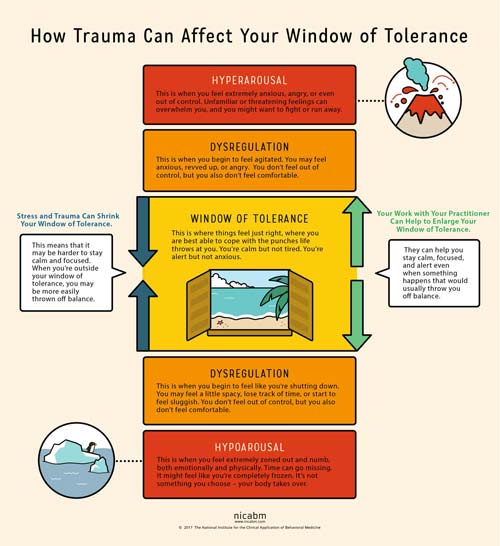EMDR, Anxiety, and you!
So maybe you’ve heard of Eye Movement Desensitization and reprocessing (EMDR), maybe not. If you have it has likely been more focused on PTSD and other trauma disorders than treatment of straight anxiety. In fact, treatment of PTSD was why I originally trained in EMDR. I was working at a group practice and found myself being assigned clients with PTSD with minimal previous training in trauma work. I had to get trained, and quickly! After my first training in EMDR I immediately found that my work with clients suffering from PTSD began to improve. I saw symptoms reduce, and positive emotional states increase. The more I training I received in EMDR, and the more positive outcomes I witnessed, the more I wanted to see how my other clients might benefit. I found that clients with general anxiety, social anxiety, OCD, situation specific fear, and phobias often respond very well to EMDR therapy. The more I use EMDR with clients who don’t have extensive trauma histories, the more often I get the question “why are we doing trauma therapy, if I don’t have PTSD?”. Great question, here is my answer!
EMDR works on reducing negative thoughts
A primary cause/symptom of anxiety (sort of a chicken/egg conundrum) are recurrent negative or worry thoughts. These thoughts often have themes that can be reduced in frequency and intensity through EMDR therapy. An example here may be helpful.
Case study: Natasha has serious anxiety at work, always has, feels that she always will. Every time Natasha’s boss comes by her desk, she can feel her heart race just a little, and her ability to concentrate on the task at hand drops to nearly nothing. Natasha’s boss has always given her positive reviews, and she has no legitimate reason to think her boss doesn’t like her, and yet Natasha has constant worry thoughts centering on her boss’s disapproval of her. Natasha comes in to therapy, because having a panic attack whenever her perfectly nice boss gets within twenty feet is not working for her anymore. Looking at the situation Natasha and her therapist realize that Natasha has some pretty entrenched negative thoughts surrounding the safety of interacting with authority figures. With her therapist’s help Natasha is able to think of memories that reinforced these negative thoughts. Natasha and her therapist reprocessed these memories using EMDR. By reprocessing these memories Natasha’s belief that showing her work to authority figures is dangerous reduced in intensity, and Natasha was able to start noticing and internalizing the praise she got for her work. There was an immediate reduction in anxiety around her boss, that got lower and lower over time.
EMDR focuses initially on increasing coping skills
While the reprocessing work in EMDR gets most of the attention, a big part of the model is in increasing coping skills before doing any reprocessing. This stage is called the preparation stage. In preparation we are looking at what you do right now to handle intense emotions, and we look at what we can add to that tool kit. What we are looking to do is increase your “affective window of tolerance”. Your affective window of tolerance is basically the amount of emotion you can handle without becoming anxious, angry, overstimulated, numb, or dissociate. Here is a handy infographic courtesy of National Institute for the Clinical Application of Behavioral Medicine (NICABM).

https://www.nicabm.com/trauma-how-to-help-your-clients-understand-their-window-of-tolerance/
Let’s go back to Natasha to see how preparation work helped her in her anxiety treatment.
Case Study: Natasha and her therapist identified that the main emotional resources that she was already using were:
- Social supports – Natasha had good friendships and was able to talk to them about her difficulties.
- Exercise – After work she went running every night and felt at peace for at least a short period of time.
Through working with her therapist Natasha was able to find other skills that were helpful:
Paced breathing techniques, guided visualizations, progressive muscle relaxation, grounding techniques, and mindfulness exercises. Learning these additional strategies, and when to use them, helped Natasha to accept and reduce her anxiety when it would have overwhelmed her in the past.
Anxiety often has roots in “little t” trauma
So here we get to the bottom line, the crux of why EMDR, a trauma therapy, works for anxiety. There is probably some trauma. Now when I say that I don’t mean that you have deep hidden abuse, or that your interpretation of your experience is invalid. Trauma is not in the experience itself, but in the brain’s response to the experience. The younger you are when something happens the more likely it will be outside of your ability to emotionally handle and process it. Stuff we haven’t processed comes out in not so fun and often clinically diagnosable ways. We call these lower level events that the brain has processed as trauma “little t traumas” (as opposed to “big T Traumas”) or adverse life events. It’s interesting, but sometimes these little t traumas can get even more stuck than big T events, because we see our emotional reaction to them as “silly” or “overdramatic” and think we should just get over them. It can feel indulgent or stupid to do trauma therapy on your best friend calling you fat in the third grade, but I encourage you to move through the self-judgment, because some there is healing to be had if you can admit that the look on her smug face haunts you sometimes. Let’s return to Natasha one final time.
Case study: Natasha recognized through her work with her therapist that the root of her fear of showing work to authority figures had roots in her father’s reactions to her school work. He didn’t hit or yell, but his constant disapproval of her work contributed to a sense that she wasn’t good enough and wasn’t capable. Natasha had long rationalized this as her father trying to help her to do her best, up her game, not just settle for good enough! And this was probably true. But it also hurt and had left lasting marks that needed to be dealt with. Through admitting the effect her father’s reactions had on her, and processing these “little t traumas” Natasha was able to gain emotional freedom from these specific negative thoughts, which was an important puzzle piece in lowering her anxiety overall.
If you would like to ask more questions about EMDR or anxiety treatment, or you’re interested in setting up an appointment, email me at jenni@jennihasenstaub.com to set up a phone consultation.
References:
NICABM. How to Help Your Clients Understand Their Window of Tolerance [Infographic]. Retrieved April 7, 2019, from https://www.nicabm.com/trauma-how-to-help-your-clients-understand-their-window-of-tolerance/
Shapiro F. Eye movement desensitization and reprocessing (EMDR): basic principles, protocols and procedures. 2nd ed. New York, NY: The Guilford Press; 2001.
